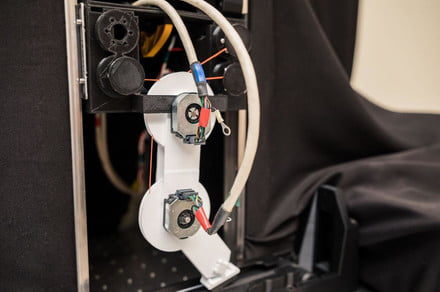A team of researchers at the USC Viterbi School of Engineering believe they have become the first to create an AI-controlled robotic limb driven by animal-like tendons that can even be tripped up and then recover within the time of the next footfall, a task for which the robot was never explicitly programmed to do. Photo by Matthew Lin. Matthew Lin
Robots suck at walking. Even the most advanced of their kind, like those developed by engineers at Boston Dynamics, have taken years to evolve beyond the sure-footedness of a toddler stumbling on an ice rink. And that’s when they’re programmed ahead of time to perform the task. But what if robots were created without the innate ability to walk? How might they find their footing?
Researchers at the University of Southern California have developed a robotic leg capable of walking without preprogrammed knowledge of how to do it. It’s an impressive feat that could help future robots navigate the world independently.
Inspired by animals like impala and wildebeest, whose young become skilled runners within minutes of birth, the USC limb uses a bio-inspired artificial intelligence algorithm to learn about its environment and refine its mobility.
“Biological systems continue to be the inspiration and envy of roboticist — even now that we have so much computational power,” Francisco Valero-Cuevas, USC engineer and lead research on the project, told Digital Trends. “So, our motivation was to see if we could learn from biology. We hope this will lead to increase the potential of robotics and artificial intelligence. We want to overcome the current gap between robots and biological systems to have robots be as versatile as possible.”
The limb developed by Valero-Cuevas and his team looks unextraordinary but it’s built using animal-like tendons that enable it to recover its footing after being tripped. Within five minutes of “free play,” the algorithm behind the robot is able to get its footing without additional programming. A robot that doesn’t need extensive programming has significant advantages over those that do, since programmers can’t always foresee for every possible scenario the robot might end up in.
“Similar to infants and juvenile vertebrates, our system starts creating an understanding about itself and its environment by random exploration of its limbs and their interaction with the environment,” Valero-Cuevas said. “But it is interesting to note that its performance can improve just by repeating a task and becoming more familiar with it. [It’s] like adopting a habit.”
Valero-Cuevas thinks his system could be used in a number of applications, including assistive robotics, search and rescue, and planetary exploration.
“In a search and rescue situation, for example, you would hope that the people and robots coming to save you would be able to handle any reasonable terrain,” he said. “If a robot gets its foot stuck in mud, is that the end of its search for you? Building algorithms that help autonomous machines learn and re-learn their dynamics means the robot can learn to wiggle its legs, and continue the mission — just like a rescue dog or human would after rain turned dirt into mud.”
A paper detailing the research was recently published in the journal Nature Machine Intelligence.
Editors’ Recommendations
- Forget wheels: This delivery robot can walk straight up to your doorstep
- Caltech’s bird-inspired robot uses thrusters to help stay on its feet
- South Korea is getting a world-class robot museum that will be built by robots
- ANYmal dog robot can get back on its feet when someone pushes it over
- Watch this weird spider robot perform a crazy aerobics routine

